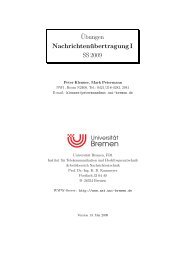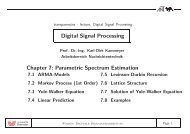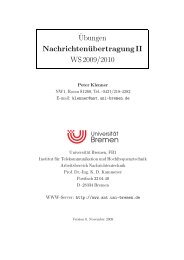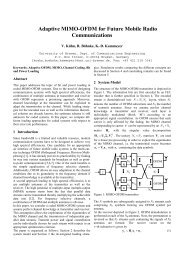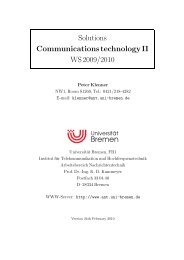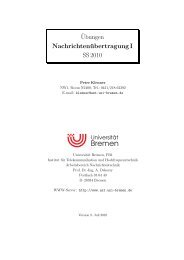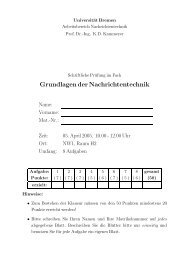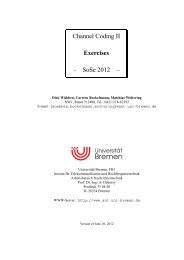Solutions Communications Technology II WS 2011/2012
Solutions Communications Technology II WS 2011/2012
Solutions Communications Technology II WS 2011/2012
- No tags were found...
Create successful ePaper yourself
Turn your PDF publications into a flip-book with our unique Google optimized e-Paper software.
<strong>Solutions</strong><strong>Communications</strong><strong>Technology</strong><strong>II</strong><strong>WS</strong><strong>2011</strong>/<strong>2012</strong>HenningSchepkerNW1,RoomN2350,Tel.: 0421/218-62393E-mail: schepker@ant.uni-bremen.deUniversitätBremen,FB1InstitutfürTelekommunikationundHochfrequenztechnikArbeitsbereichNachrichtentechnikProf.Dr.-Ing.A.DekorsyPostfach330440D–28334BremenWWW-Server: http://www.ant.uni-bremen.deVersion February 3, <strong>2012</strong>
I <strong>WS</strong> <strong>2011</strong>/<strong>2012</strong> “<strong>Communications</strong> <strong>Technology</strong> <strong>II</strong>” – <strong>Solutions</strong>Contents1 Equalization 1Solution to exercise 1(eq03) . . . . . . . . . . . . . . . . . . . . . . . . . . . . . . 1Solution to exercise 2(eq08) . . . . . . . . . . . . . . . . . . . . . . . . . . . . . . 2Solution to exercise 3(eq09) . . . . . . . . . . . . . . . . . . . . . . . . . . . . . . 3Solution to exercise 4(eq11) . . . . . . . . . . . . . . . . . . . . . . . . . . . . . . 4Solution to exercise 5(eq12) . . . . . . . . . . . . . . . . . . . . . . . . . . . . . . 52 Viterbi 8Solution to exercise 6(vit01) . . . . . . . . . . . . . . . . . . . . . . . . . . . . . . 8Solution to exercise 7(vit08) . . . . . . . . . . . . . . . . . . . . . . . . . . . . . . 9Solution to exercise 8(vit10) . . . . . . . . . . . . . . . . . . . . . . . . . . . . . . 11Solution to exercise 9(vit14) . . . . . . . . . . . . . . . . . . . . . . . . . . . . . . 12Solution to exercise 10(vit15) . . . . . . . . . . . . . . . . . . . . . . . . . . . . . . 133 Mobile Radio Channel 14Solution to exercise 11(mobrad01) . . . . . . . . . . . . . . . . . . . . . . . . . . . 14Solution to exercise 12(mobrad02) . . . . . . . . . . . . . . . . . . . . . . . . . . . 16Solution to exercise 13(mobrad03) . . . . . . . . . . . . . . . . . . . . . . . . . . . 174 OFDM 19Solution to exercise 14(ofdm03) . . . . . . . . . . . . . . . . . . . . . . . . . . . . 19Solution to exercise 15(ofdm04) . . . . . . . . . . . . . . . . . . . . . . . . . . . . 20Solution to exercise 16(ofdm05) . . . . . . . . . . . . . . . . . . . . . . . . . . . . 21Solution to exercise 17(ofdm08) . . . . . . . . . . . . . . . . . . . . . . . . . . . . 22Solution to exercise 18(ofdm09) . . . . . . . . . . . . . . . . . . . . . . . . . . . . 23
“<strong>Communications</strong> <strong>Technology</strong> <strong>II</strong>” – <strong>Solutions</strong> <strong>WS</strong> <strong>2011</strong>/<strong>2012</strong> <strong>II</strong>ConventionsandNomenclature• All references to passages in the text (chapter- and page numbers) refer to the book:K.-D. Kammeyer: “Nachrichtenübertragung”, 2.Edition, B. G. Teubner Stuttgart,1996, ISBN: 3-519-16142-7; References of equations of type (1.1.1) refer to the book,too, whereas references of type (1) refer to the solutions of the exercises.• The functions “rect(·)” and “tri(·)” are defined analogous to:N. Fliege: “Systemtheorie”, 1.Edition, B. G. Teubner Stuttgart, 1991, ISBN: 3-519-06140-6.Thus “rect(t/T)” has the temporal expanse T, whereas “tri(t/T)” is not zero for thelength of 2T.• The letters f and F represent frequencies (in Hertz), ω and Ω angular frequencies (inrad/s). The following relations are always valid: ω = 2πf resp. Ω = 2πF.• “δ 0 (t)” denotes the continuous(!) Dirac-pulse, whereas “δ(i)” represents the timediscreteimpulse sequence.• So called “ideal” low-, band- and highpass filter G(jω) have value ’1‘ in the respectivepassing range and value ’0‘ in the stop range.• If a time-discrete data sequence d(i) of rate 1/T stimulates a continues filter withimpulse response g(t), it has to be interpreted as[ ]∞∑∞∑x(t) = T d(i)δ 0 (t−iT) ∗g(t) = T d(i)·g(t−iT).Abbreviationsi=−∞i=−∞ACF auto-correlation function, sequence ISI inter-symbol interferenceBW, BB bandwidth, baseband KKF cross-correlation function, sequenceBP bandpass AF audio frequencyDPCM differential PCM PCM pulse-code modulationF{·} Fourier transform PR partial responseH{·} Hilbert transform S/N = SNR signal-to-noise ratioHP highpass LP lowpassAvailabilityonInternetPDF-files of the exercises can be downloaded from:http://www.ant.uni-bremen.de
1 <strong>WS</strong> <strong>2011</strong>/<strong>2012</strong> “<strong>Communications</strong> <strong>Technology</strong> <strong>II</strong>” – <strong>Solutions</strong>1 EqualizationSolution to exercise 1 (eq03):a) DFE block diagram:y i q ( )y( i)+-2z -1b)c(i) = [ √ 1 1; √ ]2 2y(i) = d(i)∗c(i)+n(i)= 1 √2·d(i)+ 1 √2·d(i−1)+n(i)y q (i) = √ 2·y(i)− ˆd(i−1)no wrong decisions: ˆd(i−1) = d(i−1)The DFE amplifies the noise by 3dB.= d(i)+d(i−1)+ √ 2·n(i)− ˆd(i−1)y q (i) = d(i)+ √ 2·n(i)c)E bN 0= 10dB = 10γq 2 = 1 S/N-loss caused by noise amplification in task b)2 (√ )P b = 1 2 erfc Eb·γqN 2 = 1 (√ )0 2 erfc 5= 1 2 erfc(2.23)= 8·10 −4
“<strong>Communications</strong> <strong>Technology</strong> <strong>II</strong>” – <strong>Solutions</strong> <strong>WS</strong> <strong>2011</strong>/<strong>2012</strong> 2Solution to exercise 2 (eq08):a) Impulse response of the total system:f(t) = g(t)∗c(t)∗h(t) = g(t)∗h(t)∗c(t)(whereg(t)∗h(t)is given exercise)1.51.00.52 3sampling returns f 2 (k) = {0.5, 1.5, 1.5, 0.5}b) T/2 - equalization: total impulse response is convolution off 2 (k) and e T/2 :With f 2 (k)∗e T/2 (k) = the result is0.75 · (0.5 1.5 1.5 0.5+ −0.25 · ( 0.5 1.5 1.5 0.5)0.375 1.125 1.125 0.375(−) 0.125 0.375 0.375 0.125= [0.375 1.0 0.75 0 −0.125] Tc) Sampling with even k gives [1.0 0] T which is an undistorted system.d) Sampling of total impulse response of task a) at symbol clock:f(i) = [1.5 0.5] TThe result is f(i)∗e(i) =−0.0012 0.0039 0.9987 −0.2997−0.0004 0.0013 0.3329 −0.0999[ −0.0012 0.0035 1.0000 0.0332 −0.0999 ] T
3 <strong>WS</strong> <strong>2011</strong>/<strong>2012</strong> “<strong>Communications</strong> <strong>Technology</strong> <strong>II</strong>” – <strong>Solutions</strong>Solution to exercise 3 (eq09):a) Total impulse response:g(i) = f(i)∗e(i) = [1,−α,+α 2 ,−α 3 ,0]+[0,α,−α 2 ,α 3 ,−α 4 ]g(i) = δ(i)−α 4 ·δ(i−4)b)G(z) = 1−α 4 z −4z 0,ν = |α|·e j·π 2·ν , ν = 0...3c) ( SN)d) General equalizer of the order n:e(i) =ISI= 1 α 8Max{∆d(i)} = α 4∑n−1(−1) l α l δ(i−l)l=0f(i)∗e(i) = δ(i)−(−1) n ·α n ·δ(i−n)( S=N)1ISIα 2nMax{∆d(i)} = α n
“<strong>Communications</strong> <strong>Technology</strong> <strong>II</strong>” – <strong>Solutions</strong> <strong>WS</strong> <strong>2011</strong>/<strong>2012</strong> 4Solution to exercise 4 (eq11):a)+y(i)d(i)Z -1Z -1b)0.5y(i) = x(i)−0.5· ˆd(i−2)= d(i)+0.5·d(i−2)+n(i)−0.5· ˆd(i−2)= d(i)+0.5·d(i−2)+0.5·d(i−2)+n(i)= d(i)+d(i−2)+n(i)c) .d(i) d(i-2) y(i)error-probability1 1 2+n 01 -1 0+n 1/2-1 1 0+n 1/2-1 -1 -2+n 0P b = 1 4 ·(1 2 + 1 2 ) = 1 4The power of the noise has no influence as long as it is so small that}y(i) = 2+nlead to safe decisionsy(i) = −2+n
Im5 <strong>WS</strong> <strong>2011</strong>/<strong>2012</strong> “<strong>Communications</strong> <strong>Technology</strong> <strong>II</strong>” – <strong>Solutions</strong>Solution to exercise 5 (eq12):a) Since x(i) = d(i−1)·0.5·e jπ/4 +d(i), the admissible values for x(i) are given byd(i) d(i−1) x(i)+1+j +1+j +1+j ∗(1+ √ 0.5)+1+j −1+j +1− √ 0.5+j+1+j −1−j +1+j ∗(1− √ 0.5)+1+j +1−j +1+ √ 0.5+j−1+j +1+j −1+j ∗(1+ √ 0.5)−1+j −1+j −1− √ (0.5)+j−1+j −1−j −1+j ∗(1− √ 0.5)−1+j +1−j −1+ √ 0.5+j−1−j +1+j −1+j ∗(−1+ √ 0.5)−1−j −1+j −1− √ 0.5−j−1−j −1−j −1+j ∗(−1− √ 0.5)−1−j +1−j −1+ √ 0.5−j+1−j +1+j +1+j ∗(−1+ √ 0.5)+1−j −1+j +1− √ 0.5−j+1−j −1−j +1+j ∗(−1− √ 0.5)+1−j +1−j +1+ √ 0.5−jReb) The impulse response of the overall system is given by w(i) = ∑ ιh(ι)g(i−ι). Thus,w(0) = h(0)e(0) = 1w(1) = h(1)e(0)+h(0)e(1) = e j5π/4 +e jπ/4 = 0w(2) = h(1)e(1) = (0.5) 2 ·e j(5π/4+π/4) = −0.25j.c) Since z(i) = d(i)∗w(i) = d(i−2)·0.25·e j3π/2 +d(i), the admissible values for y(i) aregiven by
“<strong>Communications</strong> <strong>Technology</strong> <strong>II</strong>” – <strong>Solutions</strong> <strong>WS</strong> <strong>2011</strong>/<strong>2012</strong> 6d(i)d(i−2) y(i)+1+j +1+j +1.25+j ∗0.75+1+j −1+j +1.25+j ∗1.25+1+j −1−j +0.75+j ∗1.25+1+j +1−j +0.75+j ∗0.75−1+j +1+j −0.75+j ∗0.75−1+j −1+j −0.75+j ∗1.25−1+j −1−j −1.25+j ∗1.25−1+j +1−j −1.25+j ∗0.75−1−j +1+j −0.75−j ∗1.25−1−j −1+j −0.75−j ∗0.75−1−j −1−j −1.25−j ∗0.75−1−j +1−j −1.25−j ∗1.25+1−j +1+j +1.25−j ∗1.25+1−j −1+j +1.25−j ∗0.75+1−j −1−j +0.75−j ∗0.75+1−j +1−j +0.75−j ∗1.251.510.5imag0−0.5−1−1.5−1.5 −1 −0.5 0 0.5 1 1.5reald) The squared magnitude frequency response can be calculated by|W(Ω)| 2 = (1−j0.25e j2Ω )(1+j0.25e −j2Ω ) (1)= 1+0.25 2 −j0.25(e j2Ω −e −j2Ω ) (2)= 1.0625+0.5sin(2Ω) (3)
7 <strong>WS</strong> <strong>2011</strong>/<strong>2012</strong> “<strong>Communications</strong> <strong>Technology</strong> <strong>II</strong>” – <strong>Solutions</strong>1.81.61.41.2|W(Ω)| 210.80.60.40.200 pi/4 pi/2 pi 0Ω
“<strong>Communications</strong> <strong>Technology</strong> <strong>II</strong>” – <strong>Solutions</strong> <strong>WS</strong> <strong>2011</strong>/<strong>2012</strong> 82 ViterbiSolution to exercise 6 (vit01):a) S0 = {−1−j},S1 = {−1+j},S2 = {+1−j},S3 = {+1+j}S0z 0,0 = −2−2j z 2,0 = −2jz 0,1 = −2 z 2,1 = 0z 0,2 = −2j z 2,2 = 2−2jz 0,3 = 0 z 2,3 = 2z 1,0 = −2 z 3,0 = 0z 1,1 = −2+2j z 3,1 = 2jz 1,2 = 0 z 3,2 = 2z 1,3 = 2j z 3,3 = 2+2jS1S3S4d(1)=1+jd(2)=1-jd(3)=-1-jd(4)=-1+jd(5)=-1-jb)c)λ 1 = |z 0,3 −(0.5+j)| 2 = |0−(0.5+j)| 2 = 1.25λ 2 = |z 3,2 −(2+0.5j)| 2 = |2−(2+0.5j)| 2 = 0.25λ 3 = |z 2,0 −(−3j)| 2 = |−2j −(−3j)| 2 = 1λ 4 = |z 0,1 −(−2)| 2 = |−2−(−2)| 2 = 0λ 5 = |z 1,0 −(−2+j)| 2 = |−2−(−2+j)| 2 = 15∑λ i = 3.5i=1
9 <strong>WS</strong> <strong>2011</strong>/<strong>2012</strong> “<strong>Communications</strong> <strong>Technology</strong> <strong>II</strong>” – <strong>Solutions</strong>Solution to exercise 7 (vit08):a) Trellis element for 2 nd order channel:Trellis diagram for a complete sequence:ramp-up phaseS0{-1,-1}16 202142928slow down phase28 182721S {-1,1}14171217281718S {1,-1}24162181316S {1,1}3s(i)2598 24 241.5 -0.5 -1.5 2.5 -2.5 0.5b) Table with the (not standardized) partial path costs:P 1.5 -0.5 -1,5 2.5 -2.5 0.5z 0,−1 = -2.5 16 4 1 25 0 9z 0,1 = -0.5 4 0 1 9z 1,−1 = -1.5 0 16 1 4z 1,1 = 0.5 4 4z 2,−1 = -0.5 0 1 9 4z 2,1 = 1.5 4 9 1z 3,−1 = 0.5 4 4 9z 3,1 = 2.5 16 0
“<strong>Communications</strong> <strong>Technology</strong> <strong>II</strong>” – <strong>Solutions</strong> <strong>WS</strong> <strong>2011</strong>/<strong>2012</strong> 10Path: see part a)c)d(i) = 1,−1,−1,1
“<strong>Communications</strong> <strong>Technology</strong> <strong>II</strong>” – <strong>Solutions</strong> <strong>WS</strong> <strong>2011</strong>/<strong>2012</strong> 12Solution to exercise 9 (vit14):a) Symbol clock model:( )-10.8 0.6b) Calculate two signal levels:w 11 = √ 1][0.8·(1+j)+0.6·(1+j)2w 42 = √ 1][0.8·(1−j)+0.6·(−1+j)2= √ 1 ] [1.4+1.4j 2= √ 1 ] [0.2−0.2j 2≈ 1+jc) ISI (here) leads to a total number of 16 different points in the signal space:QPSK symbol space with ISI≈ 0.14−0.14j1w 22w 21 w 12w 11imag →0.50-0.5-1w 23 w 24w 32 w 31w 13 w 14w 42w 43 w 44w 33 w 34w 41-1 -0.5 0 0.5 1real →d) (Solution of the additional exercise)The average signal power ¯σ d 2 has to be calculated from the average quadratic value ofthe signal space points. This calulation is trivial for the symbol alphabet at the input:The symbol’s average power is 1, since all symbols also have the absolute value of 1.Average signal power at the channel’s output:[¯σd 2 = 1∣16 ·4·0.2+0.2j ∣∣∣2∣ ∣ √ + 8·1.4+0.2j ∣∣∣22∣ √2+ 4·∣= 1 8 ·[( 0.2 2 +0.2 2) + 2·(1.4 2 +0.2 2) + ( 1.4 2 +1.4 2)]= 1 8 ·[4·0.2 2 +4·1.4 2] = 1.0∣ ]1.4+1.4j ∣∣∣2√2Thus the signal is neither extenuated nor amplified by the channel (“neutral due topower”).
13 <strong>WS</strong> <strong>2011</strong>/<strong>2012</strong> “<strong>Communications</strong> <strong>Technology</strong> <strong>II</strong>” – <strong>Solutions</strong>Solution to exercise 10 (vit15):a) upper path: d(i) = 0 / lower path: d(i) = 10001101101010101true data sequence (bold): d(i) = 0 1 1 0 0b) estimated sequence (dashed): ˆd(i) = 1 0 1 0 0error vector: e = [∆d(i 0 ), ... ,∆d(i 0 +L f −l−1)] TL f = 4; l = 2; → L f −l −1 = 4−2−1 = 1An error vector of length 2 results: e = [∆d(i 0 ),∆d(i 0 +1)] T⇒ e = [−1, 1] Tc) To find the AC matrix for a channel of order 2 we have to determine the energy ACF ofthe error vector first:r ee (0) = ∑ νr ee (1) = ∑ νe(ν)e(ν +0) = 2e(ν)e(ν +1) = −1r ee (λ) = ∑ ν⎡⇒ R E ee =⎢⎣e(ν)e(ν +λ) = 0 forλ ≥ 22 −1 0−1 2 −10 −1 2⎤⎥⎦d) Eigenvalue equationdet(R E ee −λI) = 0(r ee (0)−λ) 2 −2|r ee (1)| 2 = 0⇒ λ min = 2− √ 2S/N-loss: γmin 2 = 2−√ 2 ˆ= 2.3dB
“<strong>Communications</strong> <strong>Technology</strong> <strong>II</strong>” – <strong>Solutions</strong> <strong>WS</strong> <strong>2011</strong>/<strong>2012</strong> 143 MobileRadioChannelSolution to exercise 11 (mobrad01):a)f D = v c 0·f 0 ·cos(α)f D0 = 185.2Hz, f D1 = 0Hz, f D2 = −151.7Hzb)10.90.80.7Amplitude0.60.50.40.30.20.10−200 −150 −100 −50 0 50 100 150 200f [Hz]c)Amplitude10.90.80.70.60.50.40.30.20.10t_0 t_1 t_2Delayd)h K (t) =n∑ρ ν ·δ(t−τ ν ) = 1+r 1 ·δ(t−τ 1 )+r 2 ·δ(t−τ 2 )ν=0n∑H K (jω) = ρ ν ·exp(−jωτ ν ) = 1+r 1 ·exp(−jωτ 1 )+r 2 ·exp(−jωτ 2 )ν=0e) H TP (jω) = H K (j(ω +ω 0 )), |f| < B/2⎧⎨[ ]1+r1 ·e −j(ω+ω 0)τ 1+r 2 ·e −j(ω+ω 0)τ 2for − BH TP (jω) =≤ f ≤ B 2 2⎩0 otherwise
“<strong>Communications</strong> <strong>Technology</strong> <strong>II</strong>” – <strong>Solutions</strong> <strong>WS</strong> <strong>2011</strong>/<strong>2012</strong> 16Solution to exercise 12 (mobrad02):a) BER for BPSK and AWGNP b = 1 2 erfc (√EbN 0)BER for BPSK and AWGN with instantaneous SNR(√ )P b (h) = 1 2 erfc |h| 2E bN 0BER for the given channel coefficentsP b (h 1 ) = 1 2 erfc (√P b (h 2 ) = 1 2 erfc (√)|0.5·exp(jπ/4)| 2E b= 1 erfc(1.12) = 0.0569N 0 2)|0.8·exp(jπ/6)| 2E b= 1 erfc(1.789) = 0.0057N 0 2P b (h 3 ) = 1 ( )2 erfc |0.1+0.2j| 2E b= 1 erfc(0.5) = 0.2398N 0 2Uniform Prob. of occurence: P 1 = P 2 = P 3 = 1/3, E b /N 0 = 7dB ≈ 5¯P b = 1 3 (P b(h 1 )+P b (h 2 )+P b (h 3 )) = 0.1008b)¯P b = 0.6P b (h 1 )+0.3P b (h 2 )+0.1P b (h 3 ) = 0.0598c) The strongest channel coefficient is h 2P b,min = P b (h 2 ) = 0.0057d) data rate R b = 1/T Baud = 1/(50 ns) = 20 Mbit/sTransmitted in 30% of all cases: ¯Rb = 0.3·R b = 6 Mbit/s
17 <strong>WS</strong> <strong>2011</strong>/<strong>2012</strong> “<strong>Communications</strong> <strong>Technology</strong> <strong>II</strong>” – <strong>Solutions</strong>Solution to exercise 13 (mobrad03):a)τ 0 = l 0 /c 0⎛ ⎞h(0) = ρ 0 ·exp⎝−j2π f 0 ·τ } {{ } 0⎠f 0 ·τ 0 = f 0l 0c 0= 2000 → h(0) = 1l 1f 0 ·τ 1 = f 0 = 4666.¯6 → h(1) =ρ 1 ·exp(−j2π (4666+0.¯6)) = 0.5·[−0.5+j ·0.866]c 0=−0.25+j ·0.433h(t) = δ(t)+(−0.25+j ·0.433)δ(t−(τ 1 −τ 0 ))b)|H(jω)| = |1+0.5·exp(−j ·2π ·0.¯6)·exp(−j ·ω ·∆τ)|∆τ = τ 1 −τ 0 = l 1− l 0= 1400mc 0 c 0 3·10 8 m/s − 600m3·10 8 m/s = 2.¯6µsMaximum, if exponent is a multiple of 2πψ 1 −ω max ∆τ = n2π ⇒ f max =−2π ·0.¯6−n2π2π∆τ=−2π ·0.¯62π ·2.¯6µs − n2.¯6µsf max = −250 kHz+n·375 kHz,n = 0,±1,±2,±3·Minimum, if exponent is an odd multiple of πψ 1 −ω min ∆τ = nπ ⇒ f min = ψ 1 −nπ2π∆τ=−2π ·0.¯62π·2.¯6µs − n2·2.¯6µsf min = −250 kHz+n·187.5 kHz,n = ±1,±3,...c)f D = f 0 · vc 0·cos(α)f D0 = f Dmax = f 0 · 150Km/h3·10 8 m/s = 138.8889Hz( πf D1 = f Dmax ·cos = √4)1 ·f Dmax = 98.2093Hz 2r(t) = s(t−τ 0 )·exp(j2πf Dmax ·t)+s(t−τ 1 )·exp(j2π0.707·f Dmax ·t)
“<strong>Communications</strong> <strong>Technology</strong> <strong>II</strong>” – <strong>Solutions</strong> <strong>WS</strong> <strong>2011</strong>/<strong>2012</strong> 182.5125 kHz21.5|H(jω)| 210.5−62.5 kHz0−200 −150 −100 −50 0 50 100 150 200f in kHz
19 <strong>WS</strong> <strong>2011</strong>/<strong>2012</strong> “<strong>Communications</strong> <strong>Technology</strong> <strong>II</strong>” – <strong>Solutions</strong>4 OFDMSolution to exercise 14 (ofdm03):a) Kernel symbol length: T s = 1∆f = 4msBandwidth: B = N ·∆f = 512kHzData rate: R = ld(M)·NT s+T g= N T = 20486ms = 341kBit/sb) FFT length: N FFT = 4096c)N FFT samples account for the interval with the length of T s , since exactly one FFT isused for the generation of the kernel symbol.Sample rate: f A = N FFTT s= 1024kHzSamples within guard interval: N g = N FFT·T sT g= 2048Transmitter power:N 0 = 2· N02 = 1.2·10−4 WsE b = E OFDMld(M)·N = 1.4Ws2048 = 6.836·10−4 WsE b= 6.836·10−4 Ws= 5.7 ≈ 7.55dBN 0 1.2·10 −4 Ws(γg 2 = 1− T )g= 2 T g +T s 3(√ )P b = 1 2 erfc Eb·γgN 2 0= 1 2 erfc(1.9488)= 3·10 −3P = E OFDM= 1.4WsT s +T g 6ms= 233.3W
“<strong>Communications</strong> <strong>Technology</strong> <strong>II</strong>” – <strong>Solutions</strong> <strong>WS</strong> <strong>2011</strong>/<strong>2012</strong> 20Solution to exercise 15 (ofdm04):a) T = 1 · 1 = Nc 1= 16 · 1= ∆f u B u 6000 0.8 3.333·10−6 sR = N c · ld(M) 3= 16· = 14.4Mbit/sT 3.33·10 −6b) T g = T −T S = NcB (1 16−1) = ( 1 −1) = 0.66µsu 6000 0,8c) N c = R·T 1 = ld(M) 13.5·106 ·3.333·10 −61 = 15 3d) The subcarrier at Ω = 8 should be switched ofÈËÖÖÔÐÑÒØ× ½ºh½¼º¼¼ ½ ¾ ¿ Å ½¼½½½¾½¿½½¾À´ÅµÀ´¡¾¡¡¡µ
23 <strong>WS</strong> <strong>2011</strong>/<strong>2012</strong> “<strong>Communications</strong> <strong>Technology</strong> <strong>II</strong>” – <strong>Solutions</strong>Solution to exercise 18 (ofdm09):a)b)γ 2 = T ( ) ( ) ( )s 1 1 1 1 1⇒ T g =T s +T g γ −1 T 2 s =γ −1 2 ∆f = 0.794 −1 10kHzT g = 25.9µsR b = N ·ld(M) ⇒ N = ⌈ R b ·(T s +T g )⌉ = ⌈629.5⌉ = 630T s +T g ld(M)c) N FFT = 1024, f a = N FFT ·∆f = 1024·10kHz = 10.24MHzd) Maximal data rate, if all subcarriers are modulated:R b = N ·ld(M)T s +T g= 1024·2125.9µs = 16.27MBit/se)∆n PiT s< 1τ max⇒ ∆n Pi < T sT g= 10025.9 = 3.86



